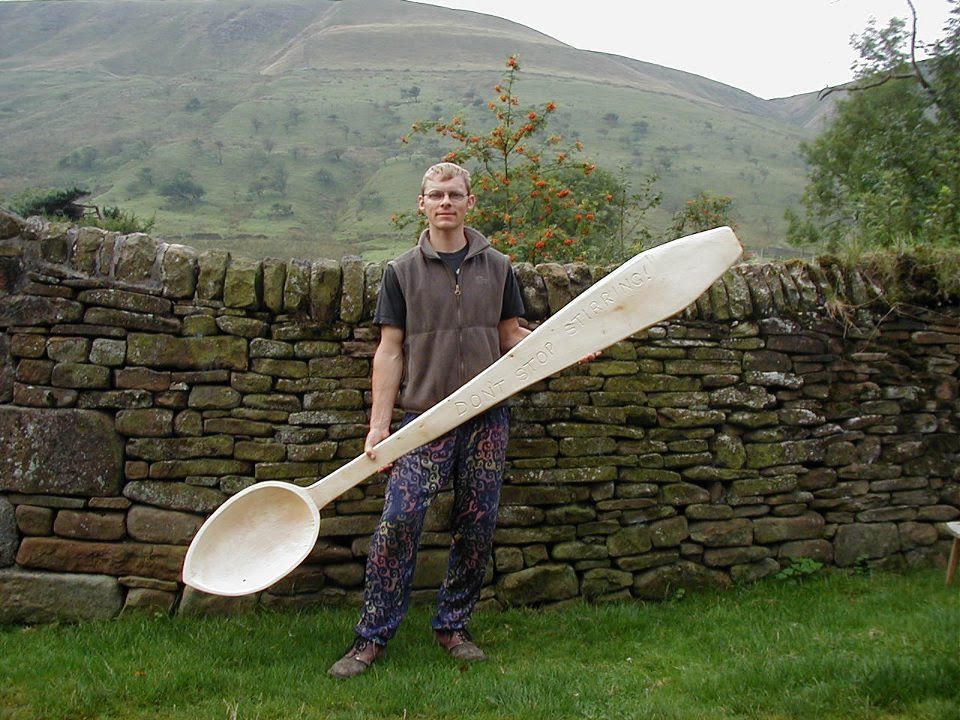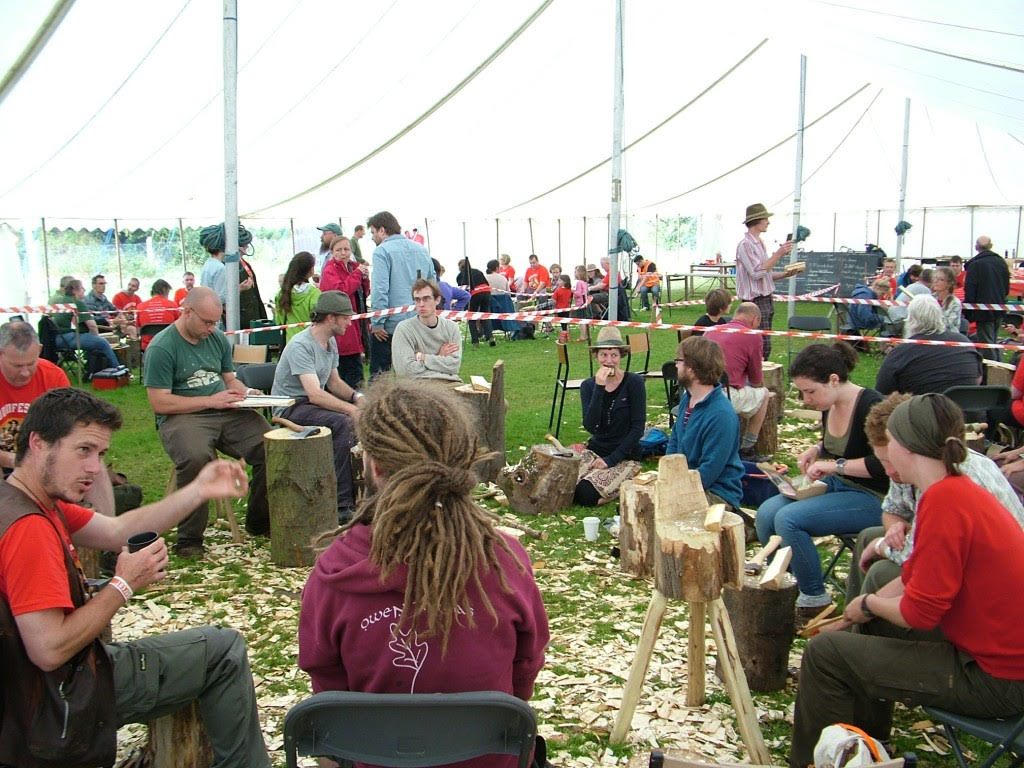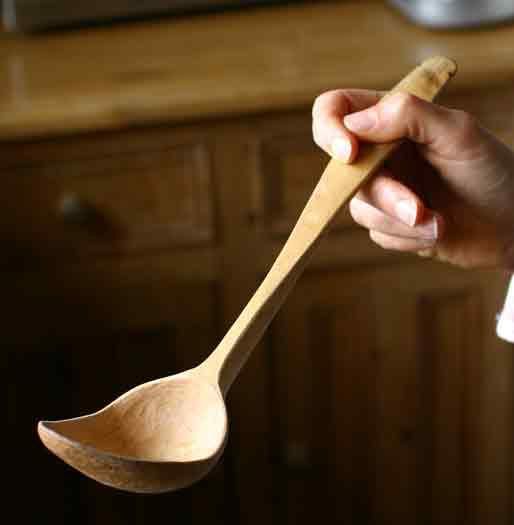Spoon Carving Has A Champion and His Last Name is Wood
 Robin Wood and one of his creations. (Photo: Courtesy Spoonfest)
Robin Wood and one of his creations. (Photo: Courtesy Spoonfest)
As far as addictions go, Robin Wood’s isn’t so bad. In fact, it’s pretty productive.
He’s addicted to carving wooden spoons. And he’s not alone.
Wood has been a woodworker for twenty years and lives in lush, rural Derbyshire, a county in central England. Wood has worked on many eclectic projects—such as building a replica of a Viking ship—but his specialty is wooden bowls, plates and spoons. In addition to selling his wares, he organizes workshops for people who want to learn more about spoon carving.

(Photo: Courtesy Spoonfest)
It was the popularity of these classes that inspired him to organize Spoonfest, a three day festival celebrating the wooden spoon. Wood and his cofounder, Barnaby Carder (aka “Barn the Spoon”), expected 50 hardcore spoon fans at the most to attend the inaugural 2012 event. He was astounded when 200 people from 11 countries signed on. This year, the fourth Spoonfest will take place in July in Edale, Derbyshire.

Attendees of the inaugural Spoonfest 2012. (Photo: Courtesy Spoonfest)
When it comes to household objects, a wooden spoon may not captivate the average person. But wooden spoon enthusiasts and carvers are legion. Carvers trade tips and photos on message boards. There are numerous how-to books and video tutorials. The spoon world has its own rockstars, such as Sweden’s Wille Sundqvist who attracts international students and is the subject of a documentary called The Spoon the Bowl and the Knife. Norwegian designer Stian Korntved Ruud garnered global media coverage for carving a spoon a day for a year. (Scandinavia is to spoon carving as the American south is to barbecue.) If the appeal of spoons still escapes you, consider this: Spoons have existed since paleolithic times. And while they evolved concurrently with humans’ proclivity for cooking, they weren’t simply used for stirring, ladling and sipping. Sub neolithic and bronze age Finnish spoons with animals heads carved in the handles have been connected to trade, shamanism and ceremonial use. Today people use “spooning” to describe cuddling, but in several parts of the world, particularly Wales, actual spoons were part of courtship. Suitors would gift their beloveds with elaborately carved “lovespoons”. A collection of lovespoons is held at the National Museum in Wales, the oldest of which is from 1667.

Wood for carving. (Photo: Courtesy Spoonfest)
Wood sees a connection between spoon carving and the modern craze for growing one’s own vegetables or keeping chickens.
“There’s a real need in society, a craving,” says Wood, “To reconnect with a simpler life, a craving to make things.”
Also, it’s affordable and portable. Spoon carving requires just three things (besides wood): An axe, a straight knife, and a bent knife—a tool that looks a bit like a hook on a handle. And once someone gets the knack of it, they can churn out a new spoon in about 20 minutes.

Sharpening axes for spoon carving. (Photo: Courtesy Spoonfest)
“Most people come into it thinking a wooden spoon is a very simple object but it’s not,” says Wood. “It’s an incredibly complex object. And to make a really, really good wooden spoon is unbelievably difficult.”
Wood estimates he has made several thousand spoons. Has he made a perfect spoon yet? Definitely not.
Wood likens a spoon carver to a sculptor, who must make a 3D object look appealing from every angle. Carvers take into account the grain of the wood, how it fits the body (both the grip and the mouth) and the depth of the bowl. Beginners will often carve the bowl too deep, says Wood. Also, an egg-shaped bowl is more pleasing to the eye than a bowl with the widest point smack in the middle. Birch is a popular choice for spoon carvers, as well as maples and fruitwoods.
It takes about 200 spoons for a carver to make one worth selling, Wood says.
“People reach that stage and it is very addictive,” says Wood. “Very, very addictive. Because by the time you’ve got to that stage and all your friends and relatives have one, you’ve become obsessed and you’re chasing that perfect spoon.”
Spoonfest attendees, much to the organizers’ surprise, are not all spoon carving veterans. Wood says Spoonfest attracts an even split of men and women and a range of skill level and backgrounds. One of the best students Wood mentored at the festival was an eye surgeon who had “incredibly good hands, particularly for doing fine detail.” This year the festival offered 200 slots for $132 a piece. They sold out in five days. Spoonfest has inspired at least one imitator: Skedfest in Sweden, which kicks off this August.
 Carving at Spoonfest. (Photo: Courtesy Spoonfest)
Carving at Spoonfest. (Photo: Courtesy Spoonfest)
Wood says that the most important thing about Spoonfest is that “there is everything that a spoon carver could want.” He describes the event as “very laid back.” Guests can camp out at the Derbyshire site, where a large tent is erected for communal carving and raw materials abound. Carving experts give free demonstrations and attendees can also pay to take hands-on workshops. Experienced carvers teach everything from how to wield an axe to how to use correct posture while carving. One year they held a Spoon Olympics in which contestants competed in games such as an egg and spoon race and an obstacle course that required carvers to stir a pot without using their hands. Attendees resorted to holding spoons in their mouths and feet. There was even a contest to decide which carver looked most like their spoon. (The winner carved his to look like a little person and affixed some of his own hair to it.)
Safety is of the utmost importance, and with proper training Wood does not think that one has to fear cutting oneself while carving. He also strongly advises that carving and drinking do not mix. The festival has only sent one person to the hospital, and that was after the person tripped over a tent peg.
The egalitarian nature of the festival and craft are one of the major appeals to Wood.
“It only takes a couple of days with a beginner who’s never done it before to make them really competent with an axe and a knife,” says Wood. “And that’s an enormously empowering thing.”

A finished spoon. (Photo: Courtesy Spoonfest)



Follow us on Twitter to get the latest on the world's hidden wonders.
Like us on Facebook to get the latest on the world's hidden wonders.
Follow us on Twitter Like us on Facebook